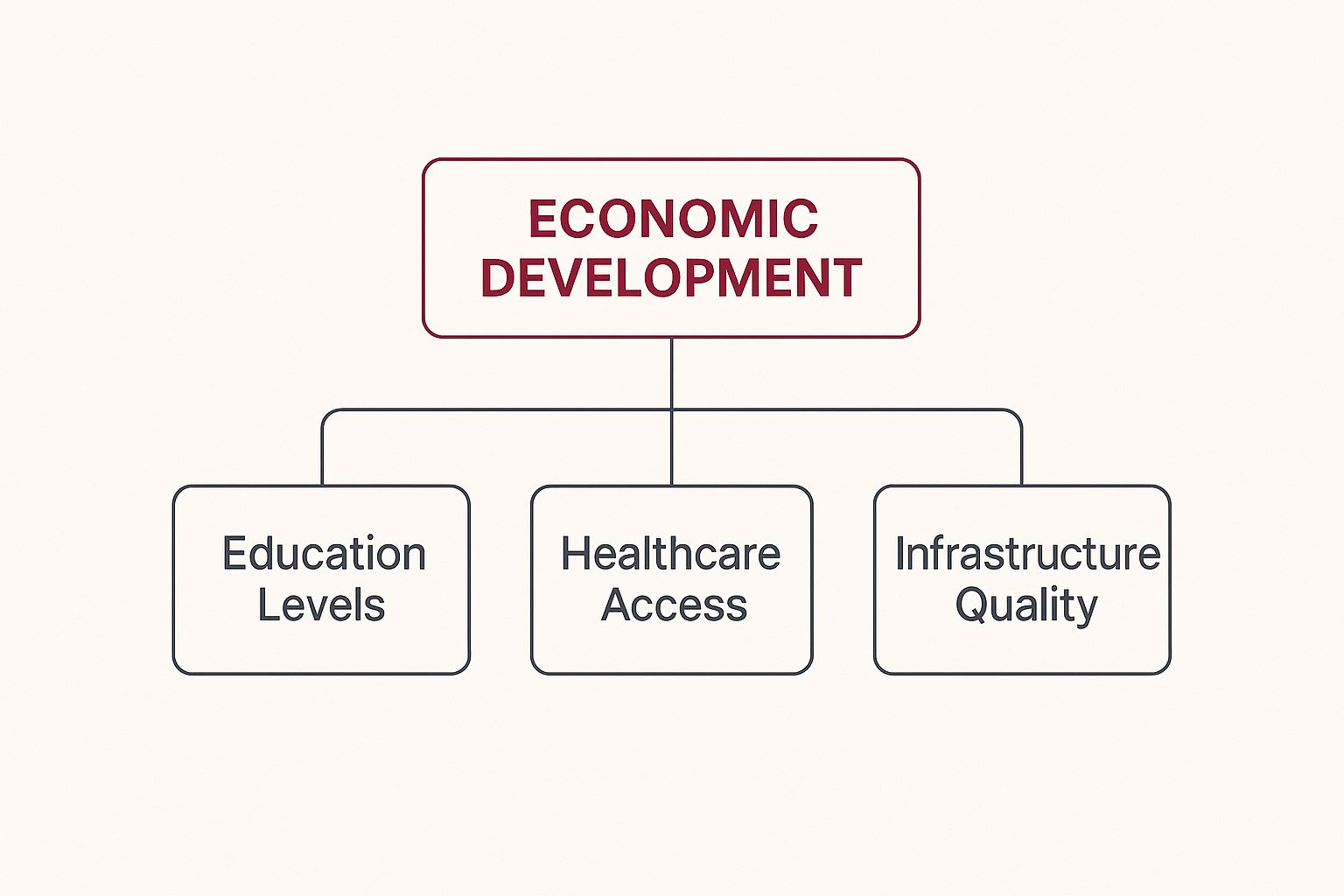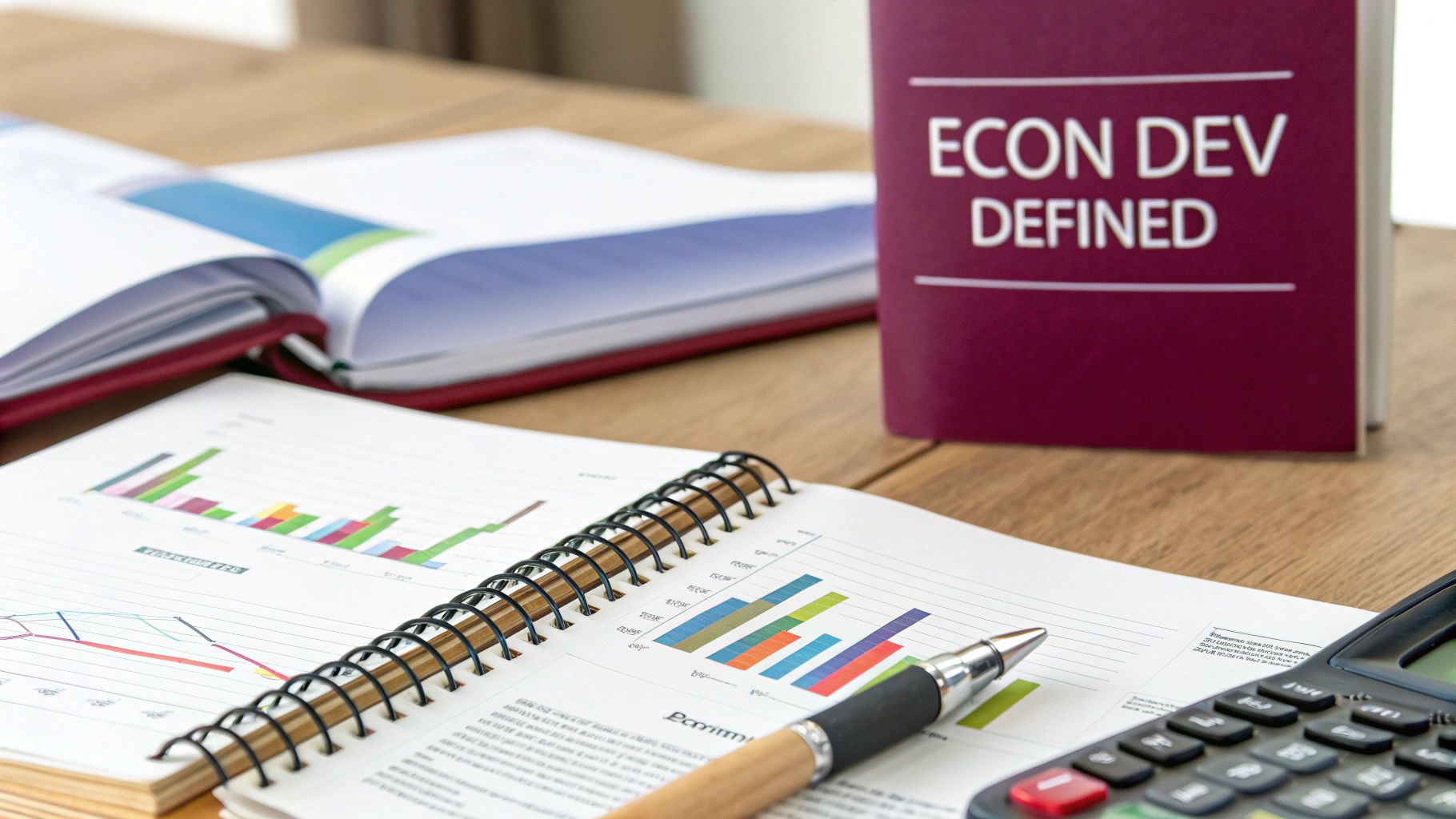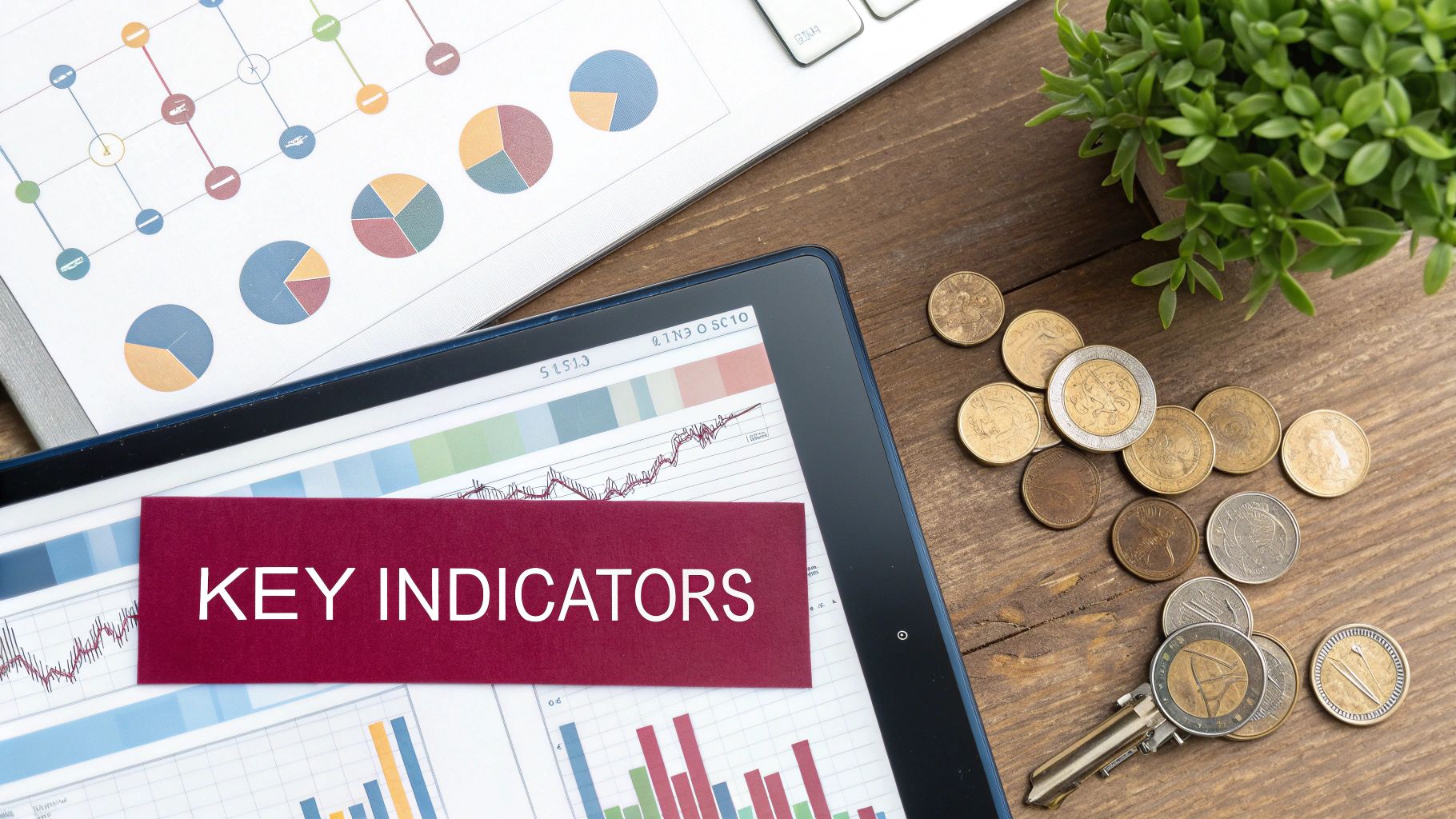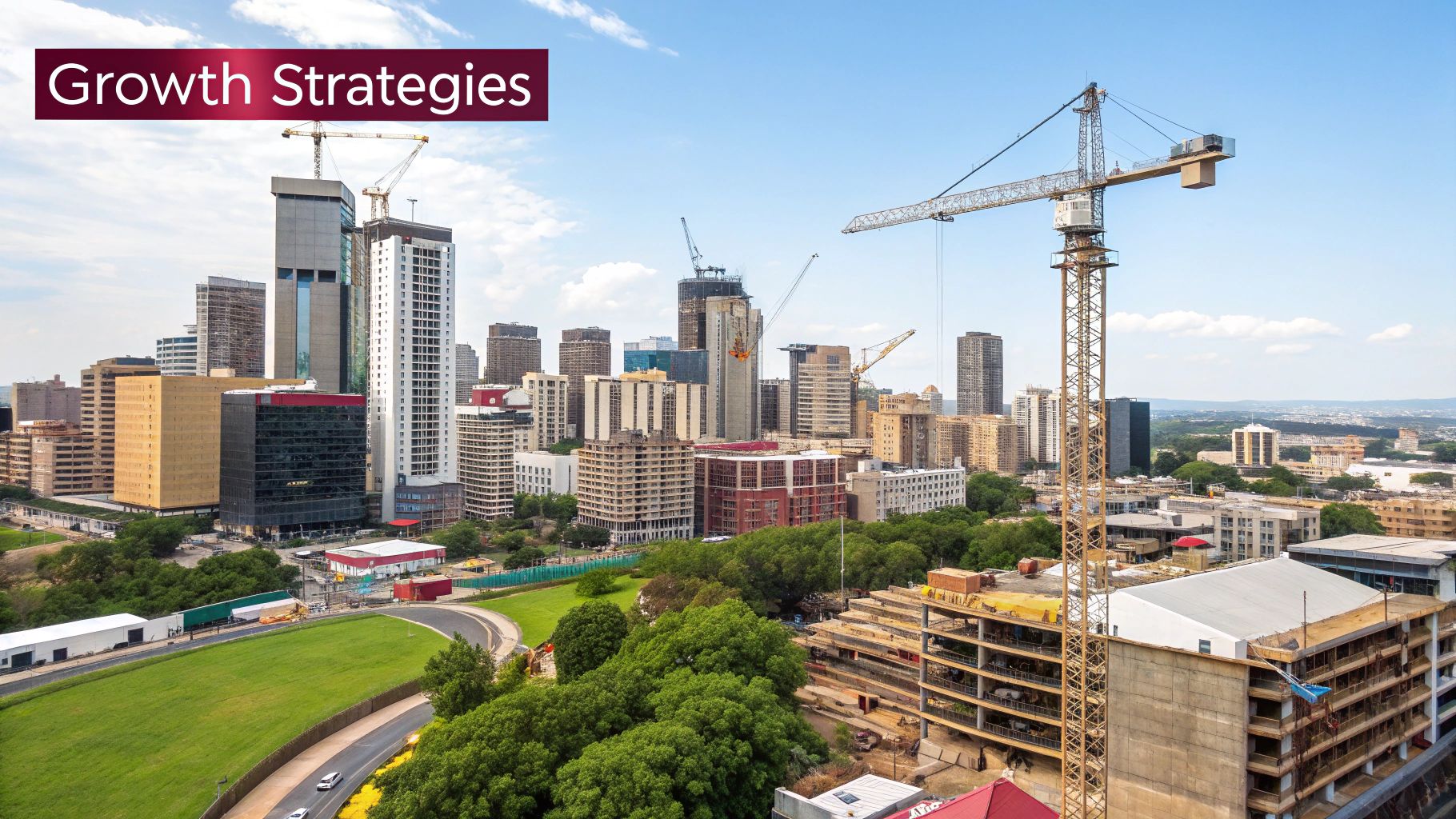What is Economic Development? Key Insights Explained
- sultan mbs
- Aug 2
- 12 min read
When you hear the term “economic development,” it’s easy to think it’s just about money—more businesses, more jobs, more tax revenue. But that’s only a tiny part of the picture. Real economic development is about something much deeper: improving a community's overall well-being and quality of life for the long haul.
It’s about creating a place where people genuinely want to live, work, and put down roots.
Going Beyond Growth to Understand Economic Development
People often use “economic growth” and “economic development” interchangeably, but they are worlds apart. Economic growth is purely about the numbers—think of it as a city’s total income going up. That’s great, but it doesn't tell you if life is actually getting better for the people who live there.
To get a real handle on economic development, let's think of a community as a garden. You wouldn't just throw down some seeds for one giant, fast-growing plant and call it a day. A smart gardener knows you have to tend to the whole ecosystem.
You'd start with the soil: This means investing in great schools and workforce training to create a deep pool of skilled, capable people.
You'd make sure there's water: This is your infrastructure—reliable roads, solid utilities, and, crucially these days, high-speed internet.
You'd plant a variety of things: A healthy garden has a mix. You need to support small businesses, nurture local entrepreneurs, and also have room for established industries to thrive.
This approach creates an environment where everyone has a chance to prosper, not just a select few. The goal is to build a resilient, adaptable community that can weather any storm. It’s a long-term commitment, not a quick fix.
Economic development isn't just a project with a start and end date. It's the ongoing work of building a stronger community from the ground up, making sure the foundational pieces are in place for both people and businesses to succeed together.
This diagram really brings the idea home, showing how all those quality-of-life factors are the true heart of economic development.

As you can see, things like education, healthcare, and infrastructure aren’t just nice side effects—they are the very pillars holding up real economic progress. When a community invests in these areas, it kicks off a powerful cycle of positive change.
For a great real-world example of this in action, just look at how [Jenks is driving major growth](https://www.thetendistrict.com/jenks/jenks-booms-riverwalk-enhancements-and-downtown-ten-district-drive-major-growth). By strategically improving its public spaces and revitalizing the downtown core, the city is attracting a wave of new businesses and residents who want to be part of the excitement.
How We Measure Real Economic Progress

So, how can we tell if all this effort toward economic development is actually working? It’s easy to get excited by a headline announcing a rise in Gross Domestic Product (GDP), but that number rarely tells the whole story. Real progress isn’t just about a figure on a spreadsheet; it’s about a tangible, noticeable improvement in people's everyday lives.
To really get what economic development is, we have to look past simple growth metrics and zero in on indicators that show genuine well-being.
Think of it like a personal health check-up. A good doctor wouldn’t just check your weight and call it a day. They’d look at your blood pressure, heart rate, and cholesterol levels to get a complete picture of your health. The same principle applies to a community’s economy.
Moving Beyond GDP
Relying only on GDP per capita is like judging a book by its cover. It's a decent starting point, but it often hides critical details, like how that new wealth is—or isn't—being shared among the population. A much more meaningful approach involves tracking a whole range of metrics that show a community is truly becoming a better place to live and work.
These are the vital signs of a healthy, thriving local economy:
Falling Poverty Rates: This is the big one. It directly measures whether economic gains are reaching the most vulnerable. When poverty rates decline, it's a clear sign that development efforts are creating opportunities for everyone, not just a select few.
Lower Income Inequality: The Gini coefficient is the go-to tool for this, measuring the gap between the richest and poorest. A lower number points to a more equitable community where prosperity is being shared.
Rising Literacy and Education Levels: A well-educated population is the bedrock of any modern economy. Seeing literacy and graduation rates climb signals that a community is investing in its future workforce and its kids.
Increased Life Expectancy: This is a powerful one. It reflects sweeping improvements in healthcare, public safety, and even nutrition. When people are living longer, healthier lives, it’s an undeniable sign of progress.
These metrics help us see if growth is both sustainable and inclusive. It’s a huge focus on the global stage, too. The World Bank recently highlighted how a slowdown in global growth projections makes it that much harder to create jobs and pull people out of poverty in developing nations.
Adopting a Holistic Framework
Since no single number can capture the full picture, many economists and policymakers now lean on composite indices. These frameworks are smart because they combine multiple indicators into a single score, giving a much more balanced view of a community's overall health.
The most famous example is the Human Development Index (HDI). It cleverly blends life expectancy, education levels, and per capita income to give a comprehensive snapshot of a country’s progress. A high HDI score suggests a nation is doing a good job of translating its wealth into a better quality of life for its citizens.
By taking this multi-indicator approach, community leaders can spot their strengths and weaknesses with incredible clarity. This kind of data-driven strategy leads to smarter investments and policies that actually work.
For those looking to get projects off the ground right here at home, check out our guide on the [12 best sources for funding for community projects](https://www.thetendistrict.com/jenks/12-best-sources-for-funding-for-community-projects-in-2025). At the end of the day, looking past the big headlines to see these measurable, human-centered outcomes is how we define—and achieve—real success.
The Engines That Drive Economic Development

If you think of a thriving economy as a powerful vehicle, what’s actually under the hood? Lasting growth doesn't just happen on its own. It's powered by a handful of key drivers that work together, creating an environment where a community can truly prosper.
When these engines are firing on all cylinders, they create the foundation for sustainable growth, pulling in both investment and talent. Let's pop the hood and take a look at the most critical parts.
The Power of People and Skills
At the absolute heart of any strong economy are its people. This is what experts call human capital—the combined skills, knowledge, and health of the population. It’s the single most valuable asset a community has.
When a region pours resources into education, from early childhood programs all the way up to universities and vocational schools, it builds a solid pipeline of talent. This skilled workforce then becomes a magnet for great industries looking for qualified people. It's a simple but powerful formula: better skills lead to better jobs, and better jobs lead to a better quality of life for everyone.
A well-trained and adaptable workforce isn't just a nice-to-have; it's a must-have for success in today's economy. It allows a community to build industries that offer real careers, not just low-wage jobs.
The Foundation of Modern Infrastructure
Ever tried to run a business with spotty electricity or attract customers when the roads are a mess? It's impossible. Solid infrastructure is the non-negotiable framework that holds up all economic activity. And today, that means more than just the basics.
Key infrastructure includes:
Modern Transportation Networks: Efficient roads, bridges, and public transit are the arteries that move goods and people.
Reliable Utilities: You can't do much without a stable power grid and clean water.
High-Speed Internet Access: In our world, broadband is as critical as electricity. It’s what enables e-commerce, remote work, and the next big idea.
This physical and digital connection is what makes business possible. To see this in action, you can check out some of the [top public-private partnership examples](https://www.thetendistrict.com/jenks/top-public-private-partnership-examples-in-2025) that have successfully modernized community infrastructure.
An Environment Built for Business
Finally, even with a skilled workforce and great infrastructure, businesses still need a stable and predictable environment to really take off. This all comes down to good governance and access to capital. Things like a stable political climate, clear and fair rules, and a local government that's actually supportive create confidence.
Entrepreneurs are far more willing to take a risk and invest when they know the rules of the game aren't going to change overnight. And that risk-taking is vital. Securing good [startup funding options](https://silvercrestfinance.com/startup-funding-options/) is often the spark that ignites the new businesses that drive a community forward. When all these pieces come together, they create fertile ground where new ideas can grow, businesses can expand, and the entire community wins.
Navigating the Major Challenges and Headwinds

The path to economic growth is rarely a straight shot. It’s more like a tough hike, full of unexpected twists and steep climbs that can slow progress to a crawl or even send you backward. To really get a grip on what is economic development, you also have to understand the major headwinds communities are constantly up against.
These challenges aren't just abstract ideas discussed in boardrooms; they hit families and businesses right where it hurts. They demand smart, forward-thinking policies to keep the momentum going and protect the progress we’ve fought so hard to achieve.
Persistent Inflation and Economic Uncertainty
One of the biggest hurdles is persistent inflation. Think of it as an invisible tax that silently shrinks everyone’s budget. When the cost of everything from groceries to gas keeps ticking up, it drains the purchasing power of local families, making it tougher to save, invest, or even cover the basics.
This uncertainty is just as damaging for businesses. When companies can’t get a clear read on what their materials, energy, or labor will cost next quarter, they get nervous. They hold off on expanding, hiring new people, or making those big, long-term investments that fuel growth. This chilling effect can bring economic progress to a grinding halt.
A stable economic climate is the bedrock of development. High inflation creates a landscape of doubt where both consumers and businesses retreat, making it exceptionally difficult to build and sustain momentum.
Often, what happens globally creates ripples right here at home. For instance, recent analysis from the OECD shows inflation is expected to hang around, with forecasts revised to 4.2 percent and 3.2 percent in the coming years. This global pressure is felt directly by local economies, highlighting just how connected everything is. You can see the full report by exploring the OECD Economic Outlook on their website.
The Bottleneck of Underinvestment
Another huge roadblock is the chronic underinvestment in two key areas: public infrastructure and private business. When a community lets its foundational assets—roads, bridges, water systems, and digital networks—fall into disrepair, it creates a massive bottleneck for everyone. This neglect doesn't just hurt productivity today; it hobbles the region's ability to compete tomorrow.
This investment gap causes a whole cascade of problems:
Deteriorating Infrastructure: Crumbling roads drive up transportation costs for businesses, and an unreliable power grid can stop a manufacturing line in its tracks.
Stifled Innovation: A lack of private investment means fewer startups, less healthy competition, and a slower-than-molasses adoption of new tech.
Reduced Competitiveness: Areas with outdated infrastructure have a tough time attracting new companies and keeping the ones they have, quickly falling behind more forward-thinking regions.
Getting past these obstacles requires a united front. It takes strong leadership to pull public and private players together around a shared vision for the future. Building that consensus is everything, and it usually starts with good old-fashioned outreach and listening. To get a better handle on this, you can learn about [9 community engagement strategies you should know](https://www.thetendistrict.com/jenks/9-community-engagement-strategies-you-should-know) that help build the trust needed for real collective action.
How Global Trade and Geopolitics Shape Local Growth
In a world this connected, it’s easy to think that what happens in our own backyard is all that matters. But the truth is, no community’s economy exists in a bubble. Events happening thousands of miles away—from fresh trade deals to international squabbles—send powerful ripples that can directly impact local job markets, business health, and our overall quality of life.
It helps to think of the global economy as a massive network of highways. Favorable trade agreements and international cooperation are like brand-new, multi-lane expressways. They open up direct routes for local businesses to sell their products to a worldwide audience, which can supercharge growth, create more jobs, and build wealth right here at home.
On the other hand, geopolitical tensions and trade disputes act like sudden roadblocks and frustrating detours. Tariffs, which are essentially taxes on imported goods, can make it more expensive for local companies to get the materials they need or sell their finished products abroad. This squeezes their profits and can grind expansion to a halt.
The link between global stability and local growth is impossible to ignore. When international relationships are strained and trade becomes a big question mark, it creates a chilling effect on investment. Businesses get hesitant to spend, and that caution can stall economic progress at every level.
The Real-World Impact on Your Town
These aren't just abstract ideas discussed on the news; they have concrete effects on the ground. Trade policies and geopolitical stability are major forces shaping what’s possible for a community. It's been shown time and again that high trade policy uncertainty and tariff barriers weaken growth forecasts.
Recent analysis from the OECD, for example, projects global growth will slow from 3.3 percent to 2.9 percent in the coming years, pinning part of the blame on these exact issues. But here's the flip side: resolving trade disputes could boost global growth by as much as 0.2 percentage points every year. You can dig into the full outlook to see how trade policy uncertainty weakens growth projections.
It's a direct line—what happens in diplomatic meetings can literally determine whether a local factory hires more workers or is forced to face layoffs.
From Global Stage to Local Attraction
This connection also works in reverse. A local community that invests in building world-class attractions can pull in global attention and visitors, turning international interest into a powerful local economic engine.
Take the [Oklahoma Aquarium’s global TripAdvisor award](https://www.thetendistrict.com/jenks/oklahoma-aquarium-makes-waves-with-global-tripadvisor-award-and-future-expansions), for instance. It’s a perfect example of how a beloved local landmark can achieve worldwide recognition, which in turn boosts tourism and funnels new revenue right into the Jenks area.
Ultimately, successfully navigating the global landscape is a core part of modern economic development. It demands that local leaders stay informed, adapt to shifting tides, and find clever ways to position their communities to thrive—no matter what challenges pop up on the world stage.
Got Questions About Economic Development? We Have Answers.
It's a term you hear thrown around a lot, from city council meetings to news headlines. But what does "economic development" actually mean for you and your community? Let's break down some of the most common questions and get straight to the point.
What’s the Real Difference Between Economic Development and Economic Growth?
People often use these terms interchangeably, but they’re two very different things. Think of it this way:
Economic growth is just a numbers game. It's a purely quantitative measure, like a company simply boosting its revenue. The number on the spreadsheet goes up, but that doesn't tell you anything about the health of the business. In city terms, we measure this with metrics like Gross Domestic Product (GDP).
Economic development, on the other hand, is about the bigger picture—the quality of that growth. It includes the numbers, sure, but it's really focused on improving the overall quality of life for everyone. We're talking about better healthcare, top-notch schools, modern infrastructure, and making sure prosperity is shared.
To use our business analogy again, development isn't just about making more money. It’s about reinvesting that money into better employee training, upgraded facilities, and a healthier company culture that benefits the entire team.
So, Who’s Actually in Charge of Economic Development?
There’s no single person or group at the helm. Successful economic development is a team sport, and it takes a village to get it right. It’s a collaborative effort with a few key players on the field.
Governments (at the local, state, and federal levels) are like the referees—they set the rules and create an environment for businesses to succeed. They’re the ones investing in big infrastructure projects, creating business-friendly policies, and sometimes offering strategic incentives to attract new players.
The private sector is the engine. These are the businesses, big and small, that create jobs, drive innovation, and make the direct investments that fuel the economy.
Economic Development Organizations (EDOs), non-profits, and universities act as the connectors and coaches. They often lead the strategic planning, run workforce training programs, and help local entrepreneurs get their big ideas off the ground.
True success almost always comes from a strong public-private partnership where everyone is working together toward a shared vision for the community.
How Does Any of This Affect Me Personally?
This is where it all hits home. When done right, economic development directly improves your day-to-day life in ways you can actually see and feel.
It means more—and better—job opportunities right here in your town. This can lead to higher wages and more stable career paths for you and your neighbors.
It also funds the public services your family depends on every day. We're talking about better-funded schools for your kids, safer parks to play in, smoother roads to drive on, and reliable public transit. Ultimately, strong economic development brings in new shops, unique restaurants, and exciting entertainment options, making your community a more vibrant, attractive, and resilient place to call home.
Ready to see what a thriving local economy looks like up close? Come experience the heart of Jenks at The Ten District, where community, culture, and commerce come together. Plan your visit today!


